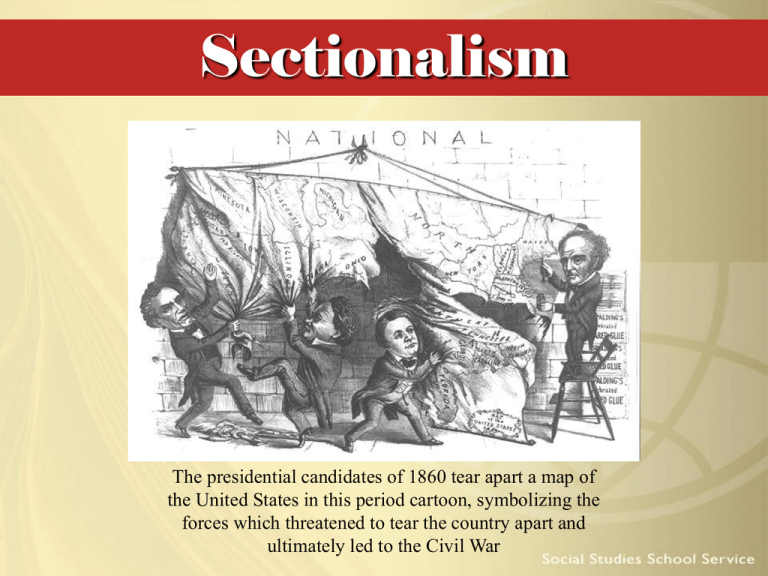Sectionalism
advertisement

Sectionalism The presidential candidates of 1860 tear apart a map of the United States in this period cartoon, symbolizing the forces which threatened to tear the country apart and ultimately led to the Civil War Sectionalism and the Constitution • Northern delegates: count slaves for taxation, but not representation • Southern delegates: count slaves for representation, not taxation • Resulted in “three-fifths compromise” • Congress agreed not to interfere with slave trade until 1808 Slavery and the Northwest Ordinance of 1787 The Northwest Ordinance • Ordinance created five new states from Northwest Territory • Slavery and involuntary servitude prohibited • Did not affect slaves already in Northwest • Some still brought slaves to territories • Pressure to continue slavery in Northwest North and South: Differences The North: • Primarily industrial • Mostly urban and small farms • Supported tariffs and internal improvements • For strong central government • Relied on free labor • Wanted to limit spread of slavery in West The South: • Primarily agricultural • Mostly small farms and plantations • Generally opposed tariffs and internal improvements • For “states’ rights” • Relied on slavery due to smaller population • Supported extending slavery in West Slavery in the Louisiana Territory • Louisiana Territory bought from France in 1803 • States admitted along similar rules as the Northwest Ordinance • Missouri applied for statehood in 1817 • Most residents were Southerners and slaveholders • Admission of Missouri as a slave state would upset balance between number of slave and free states The Missouri Compromise 36o30' • Admission of Missouri as a slave state would upset balance • Maine admitted as a free state, Missouri as slave state • 36o30' line divided rest of Louisiana Purchase into slave and free territories Slavery and the Mexican War • Many Whigs opposed the Mexican War • Feared that war would lead to expansion of slavery • Some, including Lincoln, believed the U.S. had actually been the aggressor • Democrats tended to support the war and Polk’s expansionism President James K. Polk The Mexican Cession All or part of seven states later emerged from the Mexican Cession • Ceded to U.S. at end of Mexican War (1848) • North and South soon clashed over whether territory should be slave or free • Debate intensified as California and Texas sought statehood The Wilmot Proviso • Suggested in 1846 by Rep. Wilmot during debate on a Mexican War funding bill • Amendment prohibited slavery in any territory acquired from Mexico • Passed the House, but defeated in the Senate Rep. David Wilmot The Compromise of 1850: Provisions • For the North: – California admitted as a free state – Slave trade abolished in Washington D.C. • For the South: – New Mexico and Utah Territories organized under popular sovereignty – Federal government assumed Texas’s debt; Texas gave up western land claims – More effective Fugitive Slave Law Fugitive Slave Law Controversy • Appointed federal commissioners • Could issue warrants, form posses, forcibly enlist citizens to help • Commissioners got paid for capturing slaves as well as free blacks • Accused not allowed a jury or to testify in their defense • “Personal liberty laws” An illustration condemning the Fugitive Slave Law The Abolitionist Movement • Many leaders involved in religious causes • Saw abolition as a moral or religious issue rather than political or economic • Moderates vs. radicals • Uncle Tom’s Cabin inflamed tensions • Underground Railroad also concerned Southerners Abolitionist leader William Lloyd Garrison Uncle Tom’s Cabin: The Novel • Written by Harriet Beecher Stowe in 1852 • Stowe had little personal knowledge of slavery • An immediate bestseller in U.S. and overseas • Helped to heighten sectional tensions A copy of the book printed in London Uncle Tom’s Cabin: Reactions • Stowe also condemned North for the slave trade • Most Southerners saw the book as unfair • Most Northerners dismissed Southern criticisms • Spurred Northern involvement in abolitionism Harriet Beecher Stowe “Popular Sovereignty” • Based on Enlightenment theory that government draws its power from the people • First proposed by Lewis Cass; later championed by Stephen Douglas • Residents of a territory would vote for or against slavery • Relieved Congress of having to make the decision The Kansas-Nebraska Act: Origins • Introduced by Stephen Douglas • Proposed Nebraska territory to provide northern route for transcontinental railroad • Territory lay north of Missouri Compromise line prohibiting slavery • Douglas needed Southern support • Bill allowed for popular sovereignty in territories 36o30' Kansas-Nebraska: Passage • Firestorm of controversy • Angered Free-Soilers • Douglas able to guide bill through Congress • 90 percent of Southern Congress members and half of Northern Democrats voted for bill • Nebraska divided into Kansas and Nebraska Kansas-Nebraska: Political Aftermath • Major realignment of party loyalties • Collapse of Whig Party • Democrats became strong in South, weak in North • Republican Party became dominant in the North Winfield Scott, the last presidential nominee of the Whig Party The Republican Party • Composed of several antislavery groups • Not specifically abolitionists, but opposed the expansion of slavery • Held that slavery lowered the dignity of labor and prevented social advancement • Gained abolitionist support An 1856 cartoon showing Fremont (right) and people representing the many different groups who supported the Republicans “Bleeding Kansas”: Prelude A period map showing free states (red), slave states (gray), territories (green), and Kansas Territory (white, in the center) • Pro- and antislavery settlers streamed into Kansas for slavery vote • “Emigrant aid societies” sprung up to support settlement • Pro- and antislavery voters elected separate legislatures • Kansas faced civil war “Bleeding Kansas”: Violence Erupts • “Sack of Lawrence” by proslavery forces • John Brown retaliated with a raid on Pottawatomie Creek • Both sides fearful of attacks • Guerrilla warfare broke out across territory The ruins of a hotel after the “Sack of Lawrence” “Bleeding Kansas”: Effects Missouri raiders shooting down freesoil settlers in Kansas • Brown’s attack spurred widespread violence • Republicans trumped up situation to meet their interests; Democrats heavily promoted settlement • Pierce supported proslavery forces; did nothing to quell violence Brooks Attacks Sumner A political cartoon depicts the attack • Sumner made Senate speech against Butler, Brooks’s uncle • Brooks caned Sumner into unconsciousness on Senate floor • Brooks resigned his seat, but was quickly reelected The Dred Scott Case: Origins • Slave whose master had moved him to free territory for several years • Sued for his freedom under the Northwest Ordinance and Missouri Compromise • Case appealed to U.S. Supreme Court in 1857 Dred Scott Dred Scott: The Decision Chief Justice Roger B. Taney • Chief Justice Roger B. Taney • Taney ruled against Scott: – Slaves, as non-citizens, had no constitutional rights – State laws determined a slave’s freedom, not federal – Congress’s power to create territorial rules did not include prohibiting slavery • Missouri Compromise unconstitutional Abraham Lincoln • Gained prominence in 1850s • Modest beginnings • Strong political ambitions • Opposed to the extension of slavery • Nominated for Illinois Senate Lincoln-Douglas Debates • Lincoln challenged Douglas to a series of debates • Douglas saw Lincoln as a tough opponent • Thousands viewed the pair as they spoke • Both candidates used different styles to explain their views Lincoln and Douglas spoke in seven different Illinois communities John Brown • Raised in an antislavery family • Never financially successful • Involved in abolitionist activities, including the Underground Railroad • Pottawatomie Massacre John Brown Harpers Ferry • October 1859 • Brown and followers planned to seize arsenal and arm slaves • Slaves failed to join in rebellion • Some of Brown’s men killed; he was captured Federal troops prepare to storm the arsenal at Harpers Ferry The Execution of John Brown • Brown convicted of treason against Virginia • Hanged in December 1859 • Considered a hero to many Northerners • Southerners feared that some might follow his example Brown kisses a slave child on the way to his execution Brown’s Speech Before the Virginia Court Upon receiving the death sentence for his involvement in the raid on Harpers Ferry, John Brown made the following remarks to the jury which convicted him: “Now if it is deemed necessary that I should forfeit my life for the furtherance of the ends of justice and mingle my blood further with the blood of my children and with the blood of millions in this slave country whose rights are disregarded by wicked, cruel and unjust enactments, I say, let it be done.” Southern Extremism Grows • Southerners fearful of Northern dominance • Worried that new free states would be able to abolish slavery • State legislatures restricted civil liberties; made freeing slaves illegal • Concept of secession became popular Lincoln’s “Cooper Union” Speech • February 1860, in New York City • Considered by many to be one of Lincoln’s best • Intended to validate Republican view of slavery issue • Propelled him to Republican nomination Famed photographer Mathew Brady took this picture prior to the speech From Lincoln’s Speech “Wrong as we think slavery is, we can yet afford to let it alone where it is, because that much is due to the necessity arising from its actual presence in the nation; but can we, while our votes will prevent it, allow it to spread into the National Territories, and to overrun us here in these Free States? If our sense of duty forbids this, then let us stand by our duty, fearlessly and effectively. Let us be diverted by none of those sophistical contrivances wherewith we are so industriously plied and belabored—contrivances such as groping for some middle ground between the right and the wrong, vain as the search for a man who should be neither a living man nor a dead man—such as a policy of “don't care” on a question about which all true men do care—such as Union appeals beseeching true Union men to yield to Disunionists, reversing the divine rule, and calling, not the sinners, but the righteous to repentance—such as invocations to Washington, imploring men to unsay what Washington said, and undo what Washington did. Neither let us be slandered from our duty by false accusations against us, nor frightened from it by menaces of destruction to the Government nor of dungeons to ourselves. Let us have faith that right makes might, and in that faith, let us, to the end, dare to do our duty as we understand it.” The Election of 1860: Candidates • Democrats split over slavery issue • Northern Democrats nominated Douglas; Southern Democrats ran Breckinridge • Republicans proposed diverse platform; nominated Lincoln • Constitutional Union Party formed from elements of American and Whig Parties; nominated Bell John C. Breckinridge John Bell The Election of 1860: Results • Northern states had majority of the votes, and would go either for Lincoln or Douglas • Lincoln avoided public campaigning • Douglas took MO and NJ • Breckinridge and Bell carried slave states • Lincoln handily won electoral vote Secession Begins • Lincoln’s victory seen as last straw • South Carolina seceded on December 20, 1860 • Six states followed by February 1861 • Representatives set up a provisional Confederate government in Montgomery • President Buchanan did nothing Cartoon satirizing the secession movement The Confederacy Forms Jefferson Davis • Delegates met in Montgomery in February 1861 • Davis named president, with Stephens as vice president • Confederate constitution very similar to U.S. Constitution, but guaranteed states’ rights and slavery • Upper South did not secede until after Ft. Sumter The Crittenden Compromise • Proposed December 1860 • A Constitutional amendment would: – Recognize as slavery as “existing” in any territory below the Missouri Compromise line – Keep future amendments from tampering with slavery • Lincoln refused to consider it A cartoon in which Congressmen try to force a pill labeled “Crittenden Compromise” down the throat of a man holding a document titled “Republican Platform No Compromise”



